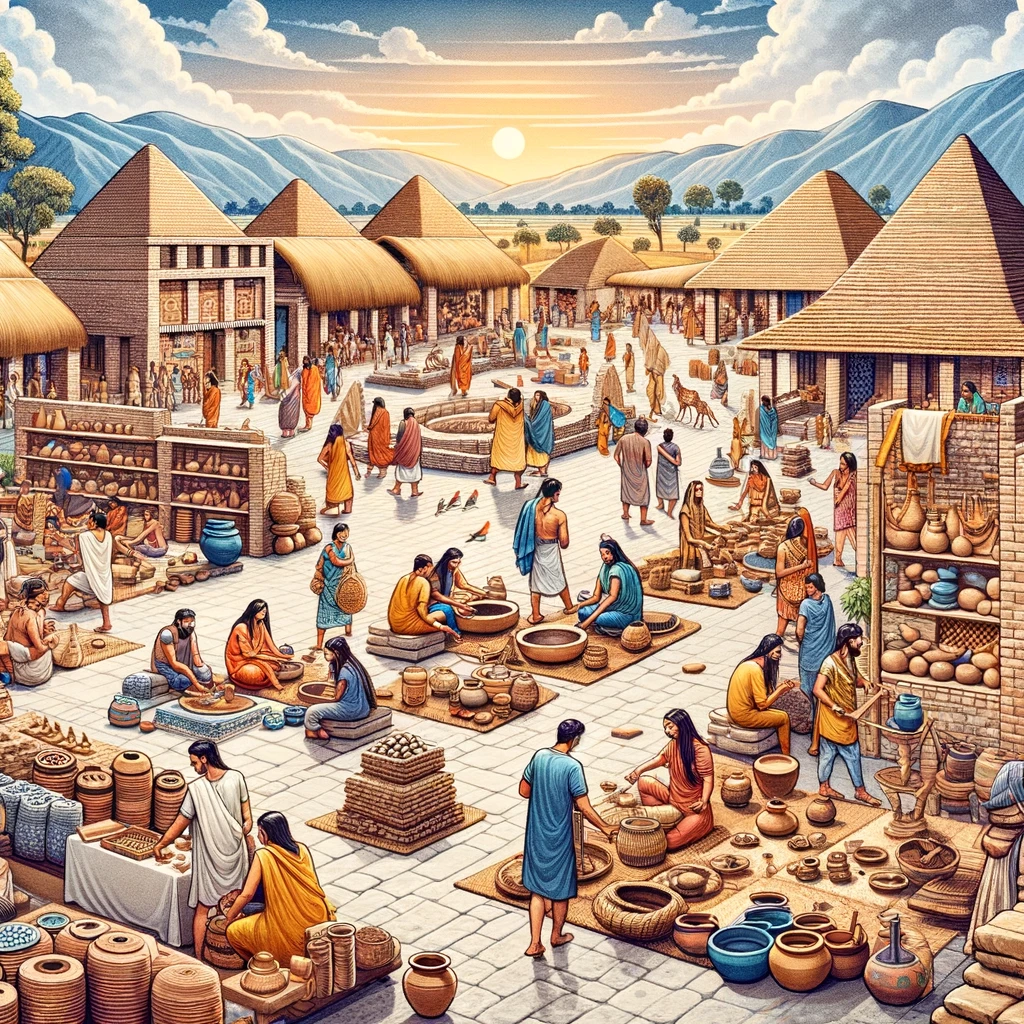The Harappan Civilization, also known as the Indus Valley Civilization, is one of the world’s oldest urban civilizations, flourishing around 2500 BCE in Pakistan and northwest India. This civilization is noted for its advanced architecture, sophisticated urban planning, and rich cultural heritage. It was contemporaneous with the civilizations of Mesopotamia and ancient Egypt, and it played a significant role in the development of human civilization.

Major Cities
Three of the most significant cities of the Harappan Civilization are Harappa, Mohenjo-Daro, and Dholavira. These cities provide a glimpse into the highly developed and organized urban lifestyle of the Harappans.
1. Harappa: Harappa, located in Punjab, Pakistan, was one of the first sites to be excavated, lending its name to the entire civilization. The city was a major center of trade and commerce, featuring well-planned streets, residential areas, and public facilities. The citadel area included large granaries, and evidence suggests the presence of advanced agricultural practices.
2. Mohenjo-Daro: Mohenjo-Daro, located in Sindh, Pakistan, is perhaps the most famous of the Harappan cities. The name means “Mound of the Dead” in Sindhi. Mohenjo-Daro is remarkable for its advanced urban planning and architecture. The city was divided into the Citadel and the Lower Town. The Citadel housed public baths, granaries, and assembly halls, indicating a well-organized administrative system. The Great Bath, a large public bathing area, is one of the most significant structures found here, suggesting the importance of ritualistic bathing.
3. Dholavira: Dholavira, located in Gujarat, India, is another key Harappan site. It is unique due to its water conservation system, which includes a series of reservoirs and water channels. Dholavira’s urban planning was meticulous, with well-defined streets and an elaborate drainage system. The city’s layout was divided into three parts: the Citadel, the Middle Town, and the Lower Town, reflecting a highly structured social organization.
Town Planning of Harrapan Civilization
The urban planning and architectural features of Harappan cities were highly advanced and indicated a deep understanding of urban life and civic management.
Grid Pattern
The cities were laid out in a grid pattern, with streets intersecting at right angles. This planning facilitated organized construction and efficient management of space. The main streets were wide and straight, with narrower lanes leading off them, indicating a clear hierarchy of road importance.
Drainage System
One of the most striking features of Harappan urban planning was the sophisticated drainage system. Each house had its own bathroom and drains that connected to a larger, covered drainage system running along the main streets. This system was designed to carry away wastewater, prevent flooding, and maintain hygiene in the city.
Building Materials and Techniques
Buildings were primarily constructed using standardized baked bricks, ensuring uniformity and stability. The use of baked bricks was a significant technological advancement, as it provided more durable and weather-resistant structures compared to sun-dried bricks.
Public Buildings and Granaries
Public buildings, such as granaries, were a common feature in Harappan cities. These granaries were strategically located near riverbanks, facilitating the easy transportation and storage of grains. The large size of these granaries indicates the importance of agriculture and a centralized storage system.
Water Management
The Harappans excelled in water management, as seen in Dholavira’s intricate water conservation system. Wells were commonly found in residential areas, ensuring a regular water supply. The Great Bath of Mohenjo-Daro is another testament to their advanced understanding of water usage and hygiene practices.
Residential Structures
Residential buildings varied in size, suggesting social stratification. Houses were built around a central courtyard, with rooms opening into it. Most houses had private wells and bathrooms, reflecting the importance placed on cleanliness and privacy.
Trade and Commerce
The layout of the cities also suggests a thriving trade network. The presence of dockyards, such as those found in Lothal (another Harappan site), indicates that the Harappans engaged in extensive maritime trade. Standardized weights and measures found at these sites further support the existence of regulated trade practices.
Conclusion
The Harappan Civilization’s advanced urban planning and architectural achievements highlight its place as a major early urban center. The meticulous town planning, sophisticated drainage systems, and well-structured residential and public buildings all reflect a highly organized and capable society. The study of Harappan cities like Harappa, Mohenjo-Daro, and Dholavira provides valuable insights into the life and times of one of the world’s earliest civilizations, making it a crucial topic for UPSC aspirants to understand the roots of Indian history and heritage.

